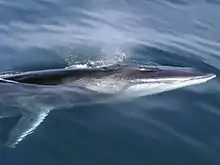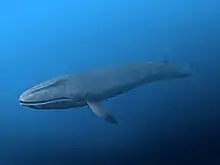| Balaenoptera Temporal range: | |
|---|---|
 | |
| Fin whale | |
| Scientific classification | |
| Domain: | Eukaryota |
| Kingdom: | Animalia |
| Phylum: | Chordata |
| Class: | Mammalia |
| Order: | Artiodactyla |
| Infraorder: | Cetacea |
| Family: | Balaenopteridae |
| Genus: | Balaenoptera Lacépède, 1758 |
| Type species | |
| Balaenoptera gibbar [1] Linnaeus, 1758 | |
| Species | |
Balaenoptera (from Latin balaena 'whale', and Ancient Greek πτερά (pterá) 'fin') is a genus of rorquals containing eight extant species.[2] Balaenoptera comprises all but two of the extant species in its family (the humpback whale and gray whale); the genus is currently polyphyletic, with the two aforementioned species being phylogenetically nested within it.[3]
This genus is known in the fossil records from the Neogene to the Quaternary (13.65 million years ago to the present).[4]
Taxonomy and systematics
The genus Balaenoptera contains the following extant species and subspecies:[2][5]
- Common minke whale (Balaenoptera acutorostrata)
- North Atlantic minke whale (Balaenoptera acutorostrata acutorostrata)
- North Pacific minke whale (Balaenoptera acutorostrata scammoni)
- Antarctic minke whale (Balaenoptera bonaerensis)
- Sei whale (Balaenoptera borealis)
- Northern sei whale (Balaenoptera borealis borealis)
- Southern sei whale (Balaenoptera borealis schlegelii)
- Bryde's whale (Balaenoptera edeni)
- Offshore Bryde's whale (Balaenoptera brydei or Balaenoptera edeni brydei) (taxonomy disputed)[6][7]
- Eden's whale (Balaenoptera edeni edeni)
- Blue whale (Balaenoptera musculus)
- Northern blue whale (Balaenoptera musculus musculus)
- Antarctic blue whale (Balaenoptera musculus intermedia)
- Northern Indian Ocean blue whale (Balaenoptera musculus indica)
- Pygmy blue whale (Balaenoptera musculus brevicauda)
- Omura's whale (Balaenoptera omurai)
- Fin whale (Balaenoptera physalus)
- Pygmy fin whale (Balaenoptera physalus patachonica)
- North Atlantic fin whale (Balaenoptera physalus physalus)
- Southern fin whale (Balaenoptera physalus quoyi)
- North Pacific fin whale (Balaenoptera physalus velifera)
- Rice's whale (Balaenoptera ricei)
Fossil species
Many fossil Balaenoptera species have been described. Some (namely B. borealina, B. definata, B. emarginata, B. gibbosa, B. rostratella, and B. sibbaldina) are either nondiagnostic, highly fragmentary, or had no holotype specimen named, hence are considered nomina dubia.[8][9] The valid fossil species of Balaenoptera are:
- †Balaenoptera bertae is a relatively small species from the Upper Miocene to Upper Pliocene Purisima Formation of California.[10]
- †Balaenoptera cephalus was originally thought to be a species of Eschrichtius (gray whales) or Cetotherium, but more recent analysis shows it to be a member of Balaenoptera.[11] Fossils of the species were found in the Calvert Formation of Maryland.[12]
- †Balaenoptera colcloughi is known from four specimens, including four skulls and some postcranial remains, found at the San Diego Formation. It was a close relative of Megaptera novaeangliae (the humpback whale), B. siberi, and B. physalus (the fin whale).[13]
- †"Balaenoptera" cortesii is a small species based on a juvenile specimen from Montezago; it probably represents a distinct, unnamed genus of balaenopterid.[8]
- †Balaenoptera davidsonii, like B. cephalus, was originally classified under Eschrichtius, but it has since been moved to Balaenoptera. It was native to the Pliocene San Diego Formation of California.[14] The only known fossil of B. davidsonii is a fragment of the left dentary.[15]
- †"Balaenoptera" portisi is based on MGPT 13803 from Montafia (originally assigned to B. cortesii by Portis [1885]), and may be the same genus or species as Cetotheriophanes capellinii. The species "B. floridana" is indistinguishable from "B." portisi.[8]
- †"Balaenoptera" ryani is a valid species but is not in fact a species of Balaenoptera. It probably represents a distinct genus of basal balaenopterid.[8]
- †Balaenoptera siberi is known from two complete skeletons. Its affinity with the genus Balaenoptera has been questioned.[8][16]
- †Balaenoptera sursiplana is a fragmentary species, based on a single fossilized tympanic bone.[17]
- †Balaenoptera taiwanica is named after Taiwan, where the fossil was found in the Pliocene-aged Cholan Formation.[18] B. taiwanica is also based on a single tympanic bone, which is similar to that of B. physalus, the fin whale.[19]
References
- ↑ Wilson, D. E.; Reeder, D. M., eds. (2005). Mammal Species of the World: A Taxonomic and Geographic Reference (3rd ed.). Johns Hopkins University Press. ISBN 978-0-8018-8221-0. OCLC 62265494.
- 1 2 "List of marine mammal species and subspecies". Society for Marine Mammalogy. May 2020. Archived from the original on July 14, 2020. Retrieved July 20, 2020.
- ↑ McGowen, Michael R; Tsagkogeorga, Georgia; Álvarez-Carretero, Sandra; dos Reis, Mario; Struebig, Monika; Deaville, Robert; Jepson, Paul D; Jarman, Simon; Polanowski, Andrea; Morin, Phillip A; Rossiter, Stephen J (2019-10-21). "Phylogenomic Resolution of the Cetacean Tree of Life Using Target Sequence Capture". Systematic Biology. 69 (3): 479–501. doi:10.1093/sysbio/syz068. ISSN 1063-5157. PMC 7164366. PMID 31633766.
- ↑ "Balaenoptera". Fossilworks.
- ↑ Perrin, William; van der Land, Jacob (August 20, 2008). "Balaenoptera Lacépède, 1804". World Cetacea Database. World Register of Marine Species. Retrieved July 20, 2020.
- ↑ Pastine, Luis A.; Acevedo, Jorge; Siciliano, Salvatore; Sholl, Thais G. C.; de Moura, Jailson F.; Ott, Paulo H.; Aguayo-Lobo, Anelio (December 2015). "Population genetic structure of the South American Bryde's whale". Revista de biología marina y oceanografía. 50 (3): 453–464. doi:10.4067/S0718-19572015000400005.
- ↑ Fordyce, Ewan; Perrin, William; Vanden Berghe, Edward (July 13, 2020). "Balaenoptera brydei Olsen, 1913". World Cetacea Database. World Register of Marine Species. Retrieved July 20, 2020.
- 1 2 3 4 5 Deméré; et al. (2005). "The Taxonomic and Evolutionary History of Fossil and Modern Balaenopteroid Mysticetes". Journal of Mammalian Evolution. 12 (1–2): 99–143. doi:10.1007/s10914-005-6944-3. S2CID 90231.
- ↑ M. Bisconti. 2007. A new basal balaenopterid whale from the Pliocene of northern Italy. Palaeontology 50(5):1103-1122
- ↑ Boessenecker, Robert W. "A new marine vertebrate assemblage from the Late Neogene Purisima Formation in Central California, part II: Pinnipeds and Cetaceans." Geodiversitas 35.4 (2012): 815-940.
- ↑ R. E. Weems and L. E. Edwards. 2007. The age and provenance of "Eschrichtius" cephalus Cope (Mammalia: Cetacea). Journal of Vertebrate Paleontology 27(3):752-756
- ↑ Balaenoptera cephalus at Fossilworks.org
- ↑ Martin. (2014). From Finbacks to Humpbacks: Investigation of the Evolutionary History of Balaenopteridae Archived 2014-07-14 at the Wayback Machine.
- ↑ Balaenoptera davidsonii at Fossilworks.org
- ↑ T. Demere. 1986. The fossil whale, Balaenoptera davidsonii (Cope 1872), with a review of other Neogene species of Balaenoptera (Cetacea: Mysticeti). Marine Mammal Science 2(4):277-298
- ↑ M. Bosselaers and K. Post. 2010. A new fossil rorqual (Mammalia, Cetacea, Balaenopteridae) from the Early Pliocene of the North Sea, with a review of the rorqual species described by Owen and Van Beneden. Geodiversitas 32(2):331-363
- ↑ E. D. Cope. 1895. Fourth contribution to the marine fauna of the Miocene period of the United States. Proceedings of the American Philosophical Society 34:135-155
- ↑ Balaenoptera taiwanica at Fossilworks.org
- ↑ T. Huang. 1966. A new species of a whale tympanic bone from Taiwan, China. Transactions and Proceedings of the Paleontological Society of Japan 61:183-187
External links
 Media related to Balaenoptera at Wikimedia Commons
Media related to Balaenoptera at Wikimedia Commons Data related to Balaenoptera at Wikispecies
Data related to Balaenoptera at Wikispecies




